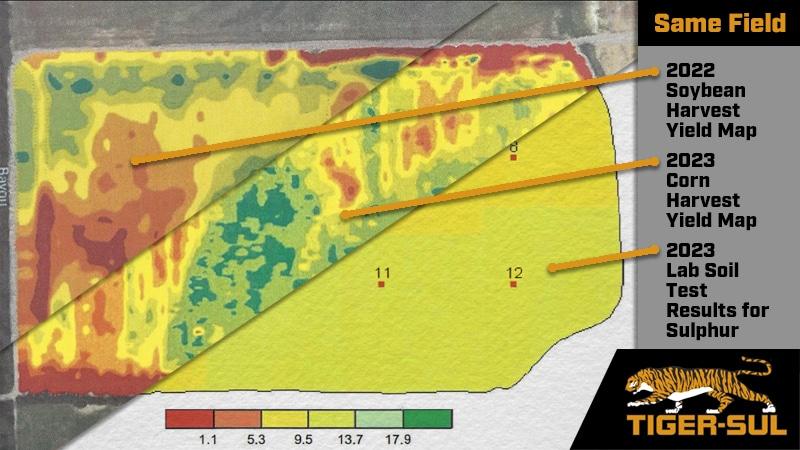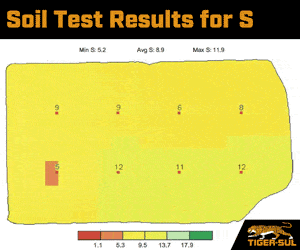CLICK HERE TO DOWNLOAD THE PDF VERSION OF THIS INFORMATION

Chuck Farr, Mid-South AG Consultants, said it all started with the soil test results and then moved to the yield maps.
Chuck Farr, Mid-South Ag Consultants
“These problems started in about 2004. We saw that soil test results didn’t show any problems with levels of phosphorus, potassium, and zinc. All were sufficient. But something was missing from our fertility program. When I laid the soil test results for sulphur over the yield maps, the lightbulb went off. Soil test sulphur levels were between 5 and 8 ppm in heavy soil.”
“It’s not just me who is seeing this. I’m talking with other consultants who have fields that are not reaching their yield potentials. I encouraged them to take the sulphur map out and lay it on top of the yield maps. They’re seeing the same thing. I believe so strongly that if soil test sulphur is under 20 ppm (40 lbs./A), the field should receive Tiger 90CR until the levels are at or over 20 (ppm). We’ve got to build the soil test levels of sulphur in the soil and AMS won’t do this. Tiger will.”
How can you argue with success? Chuck has been recommending Tiger-Sul products on his farmers’ fields for the last seven years. It started with large scale demonstrations looking at yield differences in the field and gradually moved to the point where he is making the recommendation for 10-15 lbs. of Tiger 90CR over all the acres. This doesn’t meet the sulphur uptake requirements by the plants, but Chuck is planning for long-term benefits. “I’ve got to get the sulphur level up while keeping an eye on the economics. This recommendation is less than $7.00 per acre, but I know that in both the short and long term, it’s going to pay-off.”

Figure 1: Yield results from the same field with two different crops, but one very low soil sulphur test result.
Nitrogen and sulphur work together to increase yields. Low sulphur levels with sufficient nitrogen is not enough. Sulphur increases the nitrogen use efficiency in the plant, leading to higher yields. It can be difficult to predict yield response based on specific soil test values. You may not reach full yield potential if soil test sulphur levels are below the optimum level of 15 ppm. If soil test sulphur levels are below the critical level of 10 ppm, you will probably have a yield reduction.
David Annis (CPAg, CCA), Tiger-Sul Products Market Development Manager, points out that farmers are striving for higher yields. “Perhaps farmers and consultants need to be more focused on end-of-season management. We’re already doing this in cotton with NAWF, focusing on filling the bolls that have set on the plant.” Sulphur is needed most during the reproductive growth stage. We need to ensure that we’re providing the plant adequate sulphate during this time, while increasing nitrogen use efficiency in the plants. Tiger-Sul products do this by providing season-long sulphate to the plant.
Tiger-Sul products can be applied in the fall or spring. Unlike sulphate products, Tiger-Sul products will not leach through the soil profile until after they have undergone the conversion to plant available sulphate which does not occur when soil temperature is below 55oF. Naturally occurring microbial action in the soil converts Tiger-Sul products over time, allowing for the season-long source of sulphate the plants need. As Chuck put it, “(Tiger-Sul products are) only being converted to sulphate while the plants are growing. That’s effective!”
For more information on Tiger-Sul Products and the different sulphur and micronutrient packages available, contact your Tiger-Sul Account Representative.


